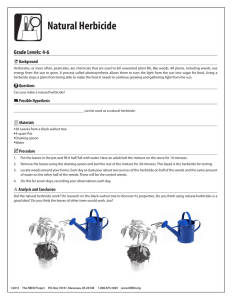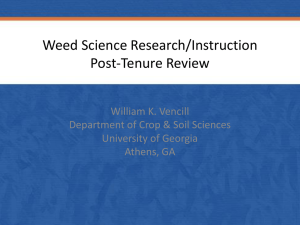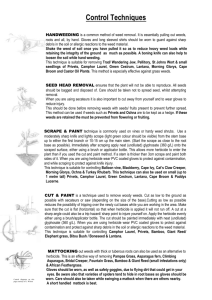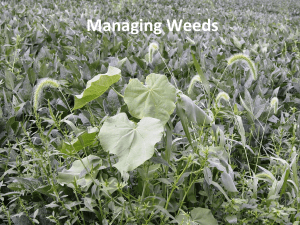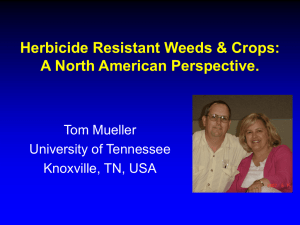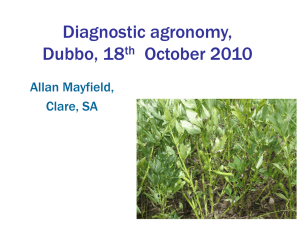PPTX - Practical Farmers of Iowa
advertisement
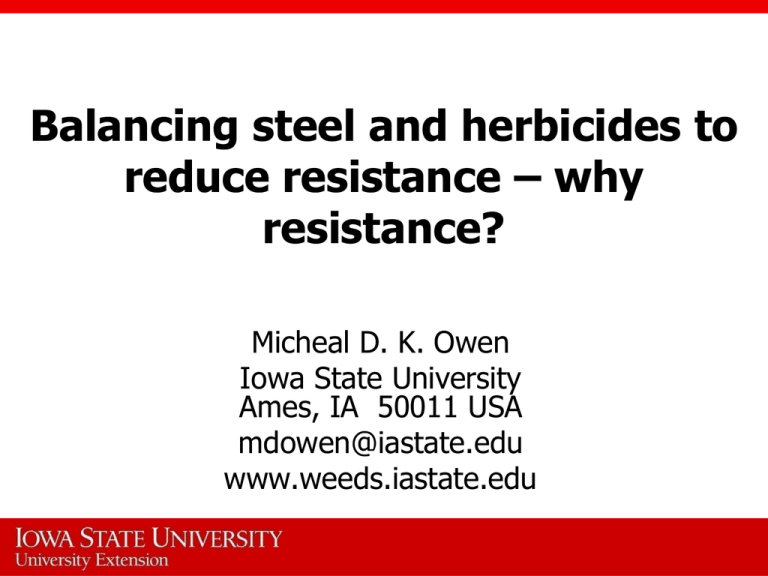
Balancing steel and herbicides to reduce resistance – why resistance? Micheal D. K. Owen Iowa State University Ames, IA 50011 USA mdowen@iastate.edu www.weeds.iastate.edu Herbicide resistance = superweeds? • While this “description” draws considerable attention (i.e. NY Times), it is clearly incorrect and inappropriate! • Organisms adapt to the selective forces that exist • Plants have impacted man since the transition from hunter/gatherer to an agrarian society – approximately 8 millennia Superweeds? Evolution does not work that way! Major weed shifts in Iowa 1950’s 2,4-D 1960’s Treflan, Prowl (trifluralin, pendimethalin) 70-80’s Lasso, Dual (alachlor, metolachlor) 80’-90’s Pursuit, Classic, etc. (imazethapyr, chlorimuron) 2000’s Roundup (glyphosate) Herbicide resistance – a historical perspective • Concern for herbicide-resistant weeds predates glyphosate by more than 50 years • The USA has a long history of herbicide-resistant weeds – Triazine resistance and ALS resistance are currently most common – Globally, resistance evolved for ~21 herbicide MOAs in 201 weed species represented by 372 weed biotypes* *www.weedscience.com Evolution of glyphosate-resistant weeds* 25 20 15 10 Global USA 5 0 *www.weedscience.com Glyphosate-resistant weeds found in Iowa Giant ragweed Common waterhemp Horseweed Marestail Ohio Weed Gothic (a study in giant ragweed)* *with apology to Grant Wood Evolution of herbicide resistance in common waterhemp State where first reported* Year Site of action Iowa and Illinois 1993 ALS inhibitors Missouri 1994 PS II inhibitors Illinois 1996 ALS and PSII inhibitors Kansas 2001 ALS and PPO inhibitors Illinois 2002 ALS, PS II and PPO inhibitors Missouri 2005 ALS and PPO inhibitors and glycines Iowa and Illinois 2009 ALS, PS II and HPPD inhibitors Nebraska 2009 Synthetic auxins Iowa 2011 ALS and HPPD inhibitors and glycines *www.weedscience.com Soybean in a common waterhemp field “Causes” of herbicide resistance • Herbicides do not “cause” weeds to evolve resistance per se • How herbicides are used “causes” weeds to evolve resistance (e.g. management) • Factors to consider – Frequency of the resistance trait in weeds – “Effectiveness” of the herbicide – Management strategies – Others (e.g. herbicide marketing) Original population – year 1 99% Control - Population still appears like the “original” 2+the - Adapted biotype quickly YearYear 4 with same weed management becomes the dominant weed program Poor control – the weed population shift is obvious and a serious problem Herbicide resistance • The evolution of herbicide not a herbicide problem • The evolution of herbicide not a trait problem • The evolution of herbicide not a glyphosate problem • The evolution of herbicide a behavioral problem resistance is resistance is resistance is resistance is Integrated Weed Management Cultural Cultural Herbicides Herbicides Current Future Conclusions • Weeds have and will inevitably adapt to what mankind provides, irrespective of technology • Current issues with Darwinian evolution (herbicide resistance – aka. “Superweeds”) are widespread and of great economic importance • The “causes” of herbicide resistance are more of a socioeconomic rather than agronomic issue • Weeds threaten global food security and society just as they have always done Questions?
